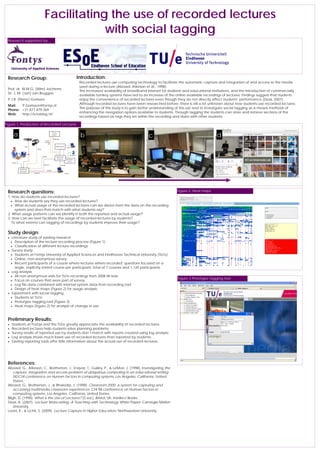
Poster 20100528
- 1. Facilitating the use of recorded lectures with social tagging Research supported by: Research Group: Introduction: Recorded lectures use computing technology to facilitate the automatic capture and integration of and access to the media used during a lecture (Abowd, Atkeson et al., 1998). Prof. dr. W.M.G. (Wim) Jochems The increased availability of broadband internet for students and educational institutions, and the introduction of commercially Dr. J. M. (Jan) van Bruggen available turnkey systems have led to an increase of the online available recordings of lectures. Findings suggest that students P.J.B. (Pierre) Gorissen enjoy the convenience of recorded lectures even though they do not directly affect students’ performance (Deal, 2007). Although recorded lectures have been researched before, there is still a lot unknown about how students use recorded lectures. Mail: P.Gorissen@fontys.nl The purpose of this study is to gain better understanding of this use and to investigate social tagging as a means methods of Phone: +31 877 879 369 enhancing the navigation options available to students. Through tagging the students can store and retrieve sections of the Web: http://ictoblog.nl/ recordings based on tags they set within the recording and share with other students. Figure 1: Production of Recorded Lectures a b c d Research questions: Figure 2: Heat maps 1. How do students use recorded lectures? How do students say they use recorded lectures? What actual usage of the recorded lectures can we derive from the data on the recording system and does that match with what students say? 2. What usage patterns can we identify in both the reported and actual usage? 3. How can we best facilitate the usage of recorded lectures by students? To what extend can tagging of recordings by students improve their usage? Study design: Literature study of existing research Description of the lecture recording process (Figure 1) Classification of different lecture recordings Survey study Students at Fontys University of Applied Sciences and Eindhoven Technical University (TU/e) Online, non-anonymous survey Recent participants of a course where lectures where recorded; questions focused on a single, explicitly stated course per participant; total of 7 courses and 1,120 participants Log analysis All non-anonymous visits for TU/e recordings from 2008 till now Figure 3 Prototype Tagging tool Focus on courses that were part of survey Log file data combined with internal system data from recording tool Design of heat maps (Figure 2) for usage analysis Experiment with social tagging Students at TU/e Prototype tagging tool (Figure 3) Heat-maps (Figure 2) for analysis of change in use Preliminary Results: Students at Fontys and the TU/e greatly appreciate the availability of recorded lectures; Recorded lectures help students solve planning problems; Survey results of reported use by students don’t match with reports created using log analysis; Log analysis shows much lower use of recorded lectures than reported by students; Existing reporting tools offer little information about the actual use of recorded lectures. References: Abowd, G., Atkeson, C., Brotherton, J., Enqvist, T., Gulley, P., & LeMon, J. (1998). Investigating the capture, integration and access problem of ubiquitous computing in an educational setting. SIGCHI conference on Human factors in computing systems, Los Angeles, California, United States. Abowd, G., Brotherton, J., & Bhalodia, J. (1998). Classroom 2000: a system for capturing and accessing multimedia classroom experiences. CHI 98 conference on Human factors in computing systems, Los Angeles, California, United States. Bligh, D. (1998). What is the Use of Lectures? (5 ed.). Bristol, UK: Intellect Books. Deal, A. (2007). Lecture Webcasting, A Teaching with Technology White Paper: Carnegie Mellon University. Leoni, K., & Lichti, S. (2009). Lecture Capture in Higher Education: Northwestern University.
